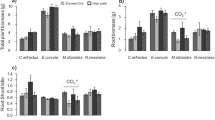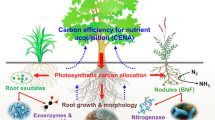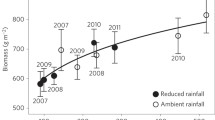Abstract
Nutrients such as nitrogen (N) and phosphorus (P) often limit plant growth rate and production in natural and agricultural ecosystems. Limited availability of these nutrients is also a major factor influencing long-term plant and ecosystem responses to rising atmospheric CO2 levels, i.e., the commonly observed short-term increase in plant biomass may not be sustained over the long-term. Therefore, it is critical to obtain a mechanistic understanding of whether elevated CO2 can elicit compensatory adjustments such that acquisition capacity for minerals increases in concert with carbon (C) uptake. Compensatory adjustments such as increases in (a) root mycorrhizal infection, (b) root-to-shoot ratio and changes in root morphology and architecture, (c) root nutrient absorption capacity, and (d) nutrient-use efficiency can enable plants to meet an increased nutrient demand under high CO2. Here we examine the literature to assess the extent to which these mechanisms have been shown to respond to high CO2. The literature survey reveals no consistent pattern either in direction or magnitude of responses of these mechanisms to high CO2. This apparent lack of a pattern may represent variations in experimental protocol and/or interspecific differences. We found that in addressing nutrient uptake responses to high CO2 most investigators have examined these mechanisms in isolation. Because such mechanisms can potentially counterbalance one another, a more reliable prediction of elevated CO2 responses requires experimental designs that integrate all mechanisms simultaneously. Finally, we present a functional balance (FB) model as an example of how root system adjustments and nitrogen-use efficiency can be integrated to assess growth responses to high CO2. The FB model suggests that the mechanisms of increased N uptake highlighted here have different weights in determining overall plant responses to high CO2. For example, while changes in root-to-shoot biomass allocation, r, have a small effect on growth, adjustments in uptake rate per unit root mass, \(\bar \nu \), and photosynthetic N use efficiency, p*, have a significantly greater leverage on growth responses to elevated CO2 except when relative growth rate (RGR) reaches its developmental limit, maximum RGR (RGRmax).
Similar content being viewed by others
Author information
Authors and Affiliations
Rights and permissions
About this article
Cite this article
BassiriRad, H., Gutschick, V. & Lussenhop, J. Root system adjustments: regulation of plant nutrient uptake and growth responses to elevated CO2 . Oecologia 126, 305–320 (2001). https://doi.org/10.1007/s004420000524
Received:
Accepted:
Published:
Issue Date:
DOI: https://doi.org/10.1007/s004420000524




